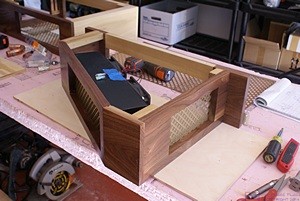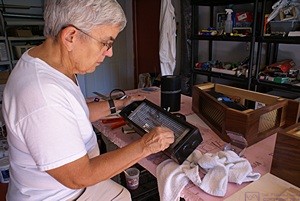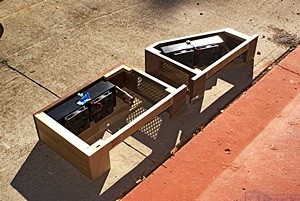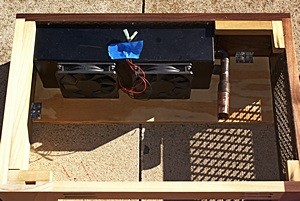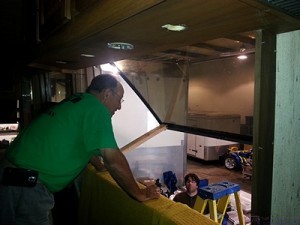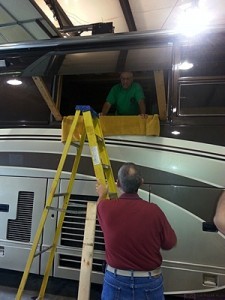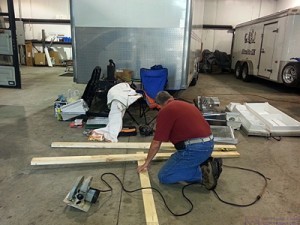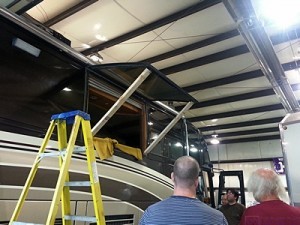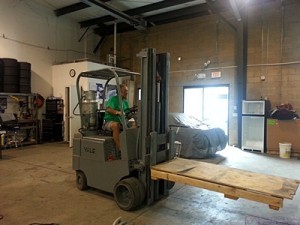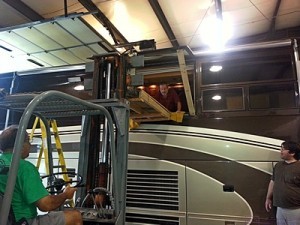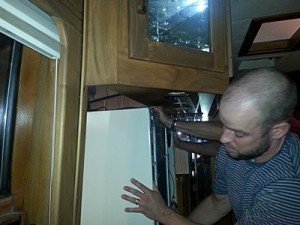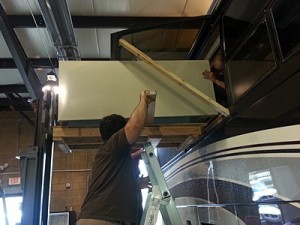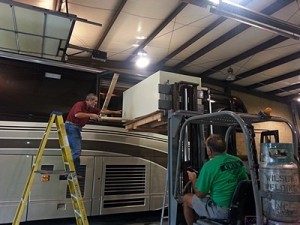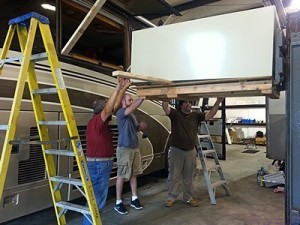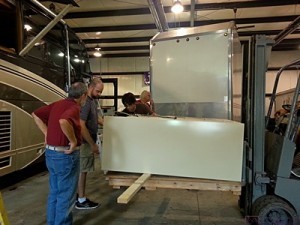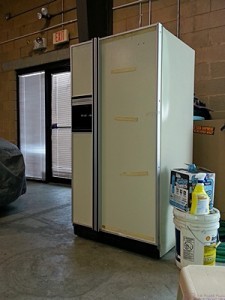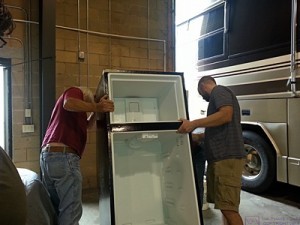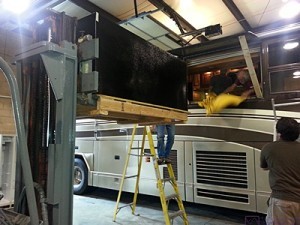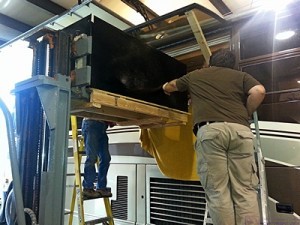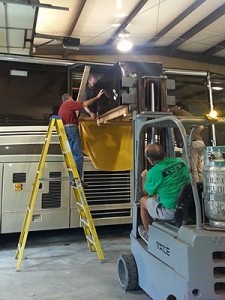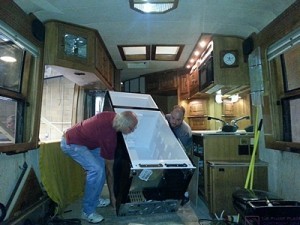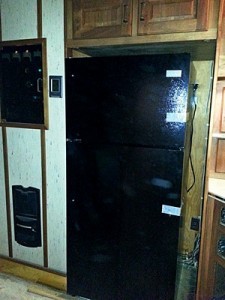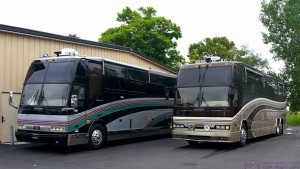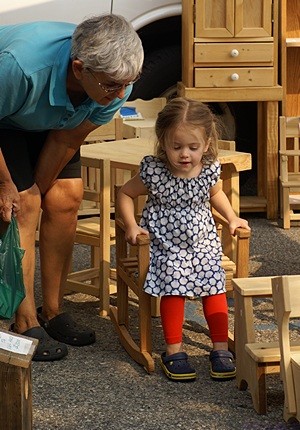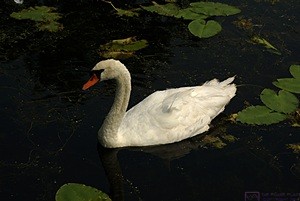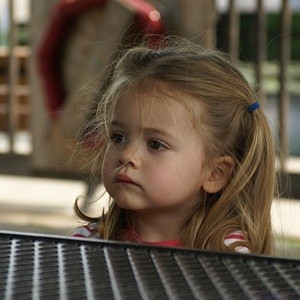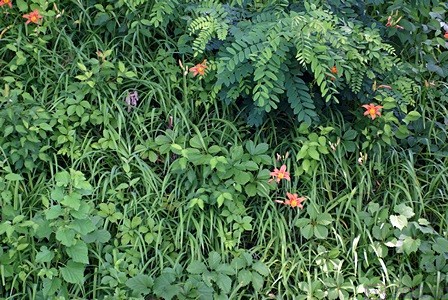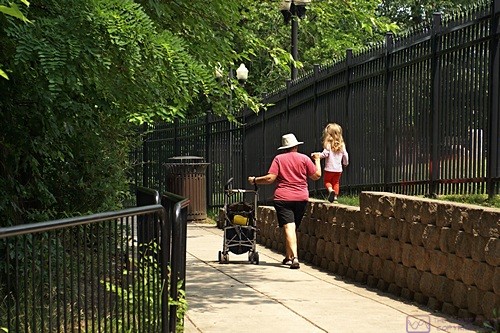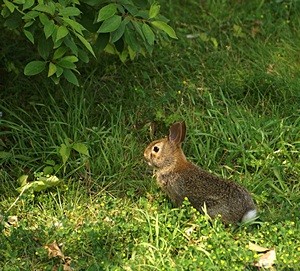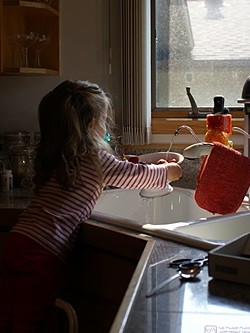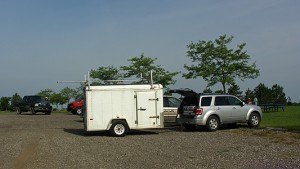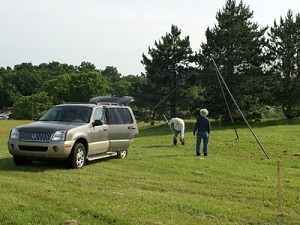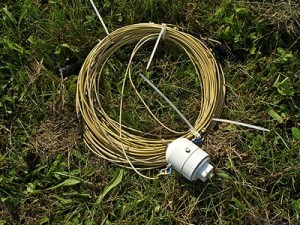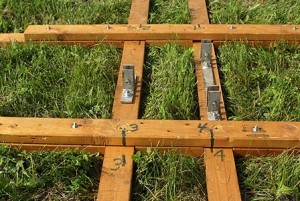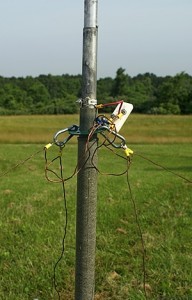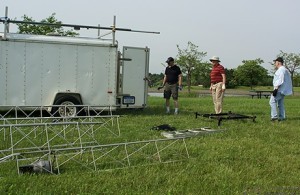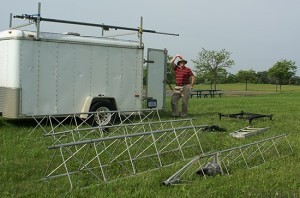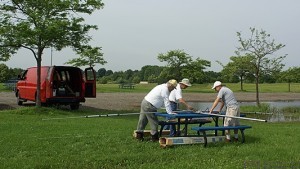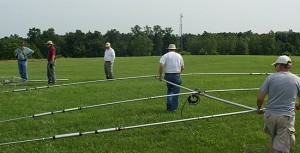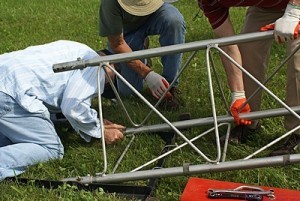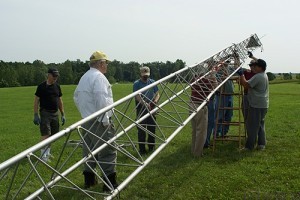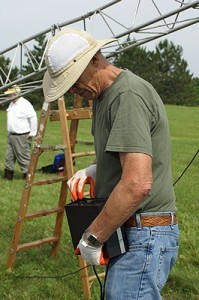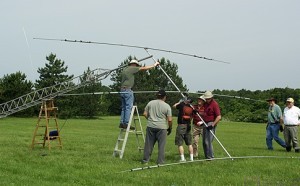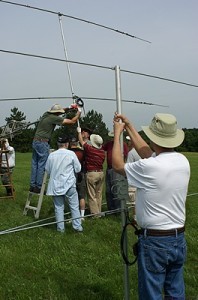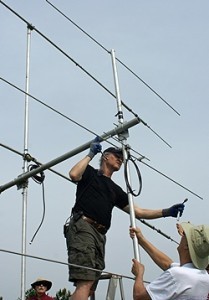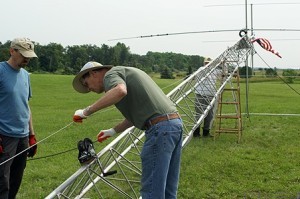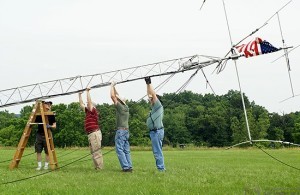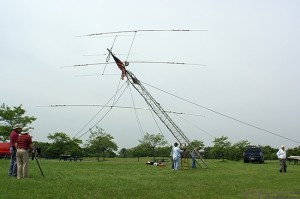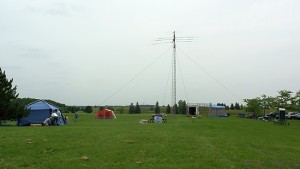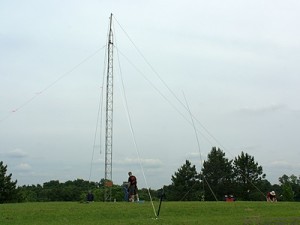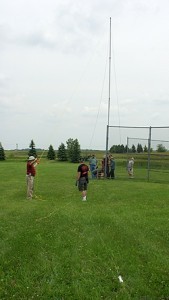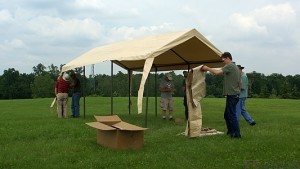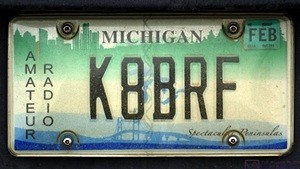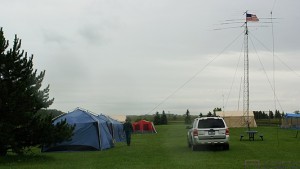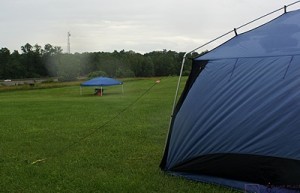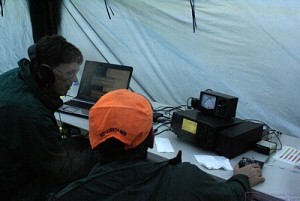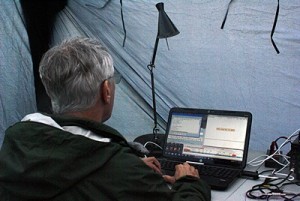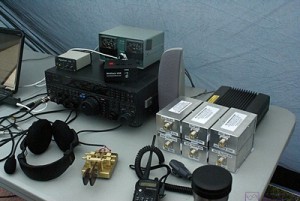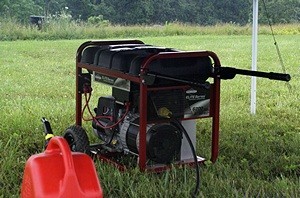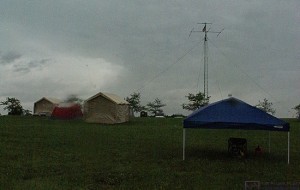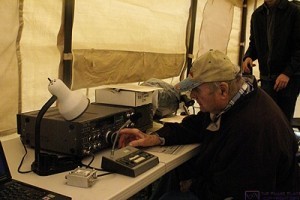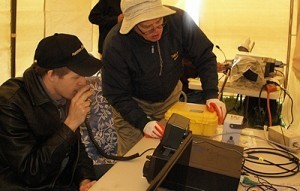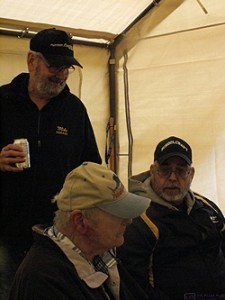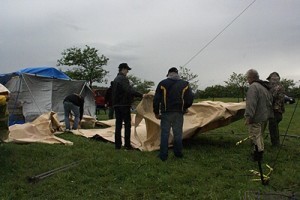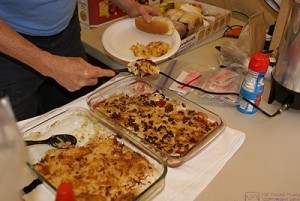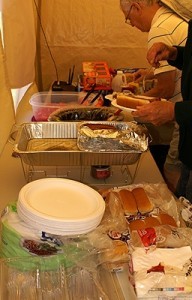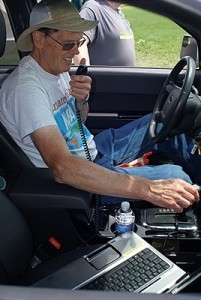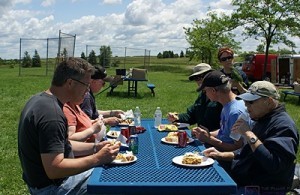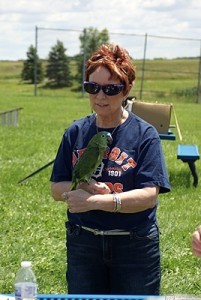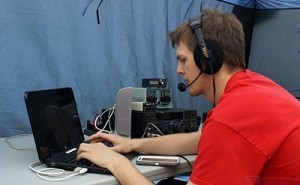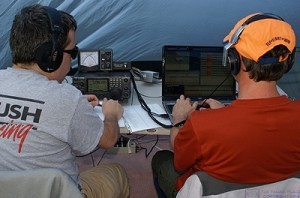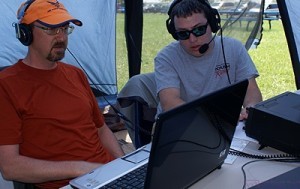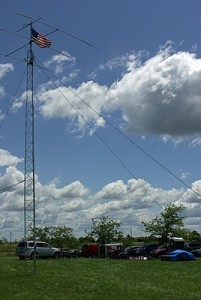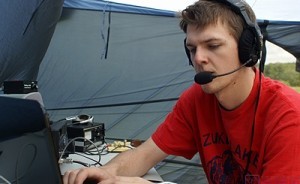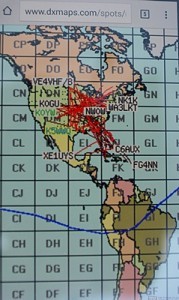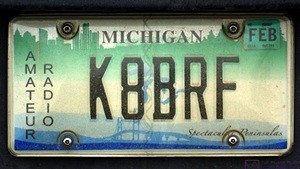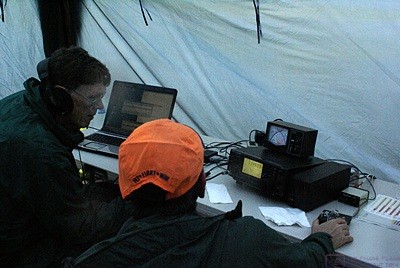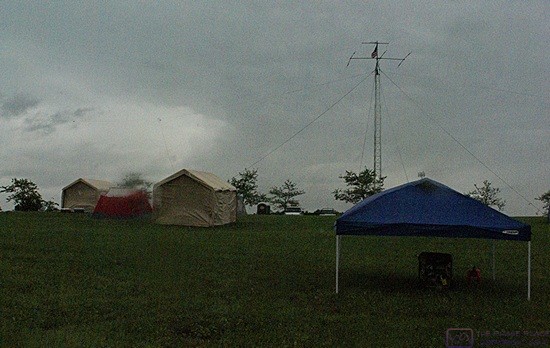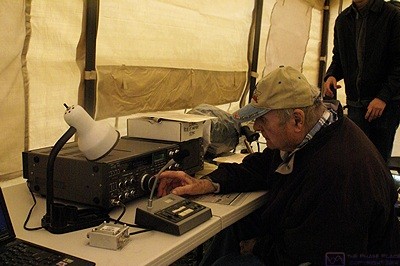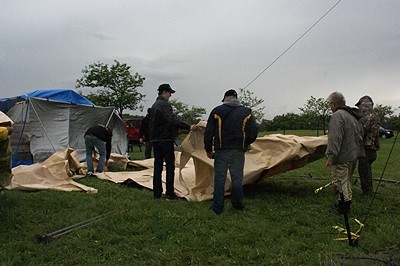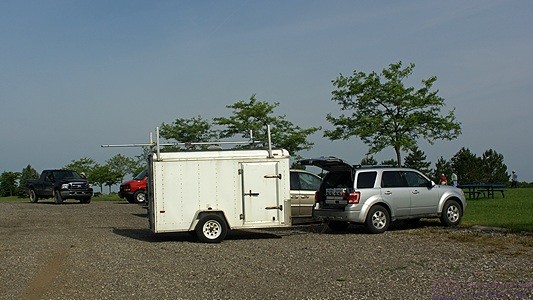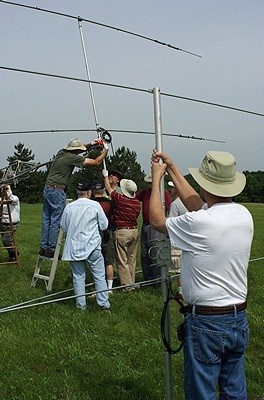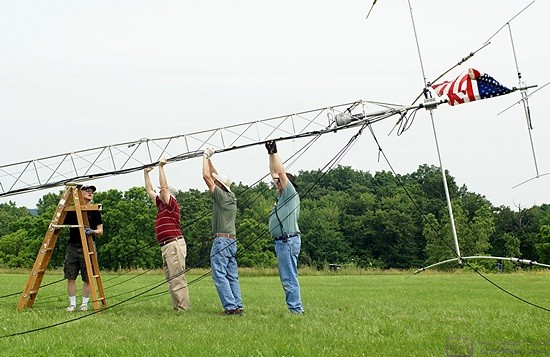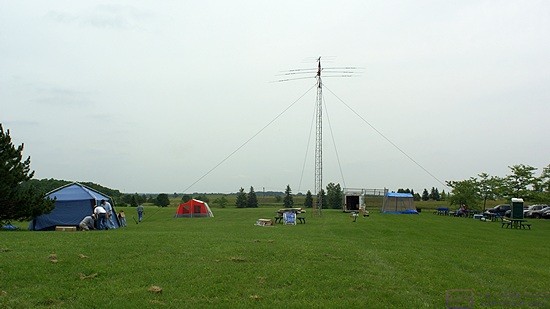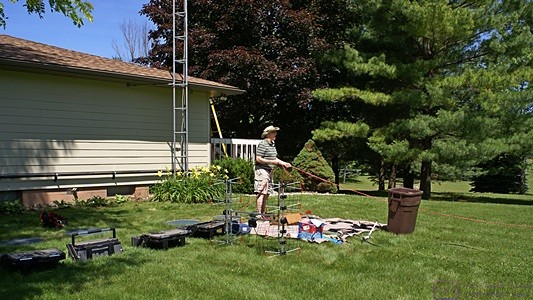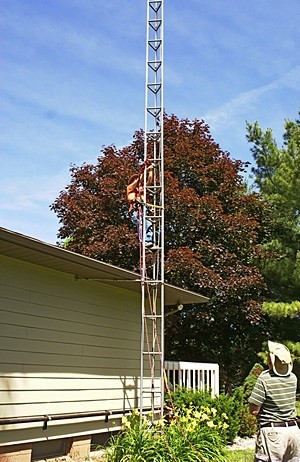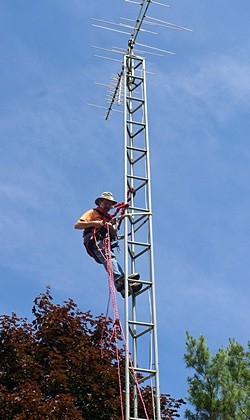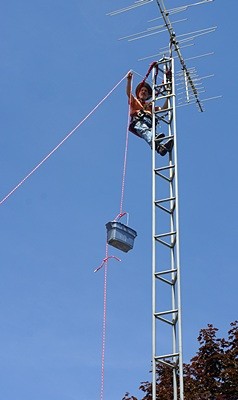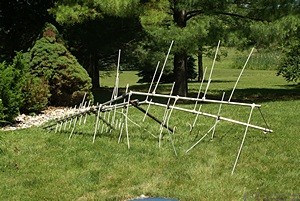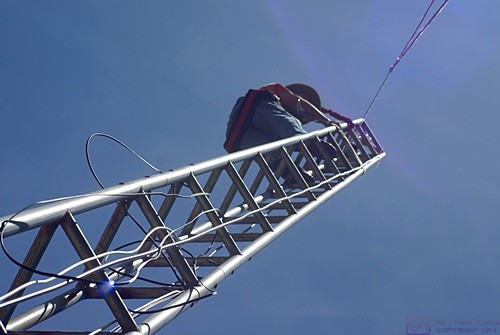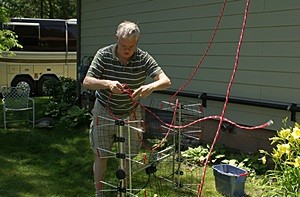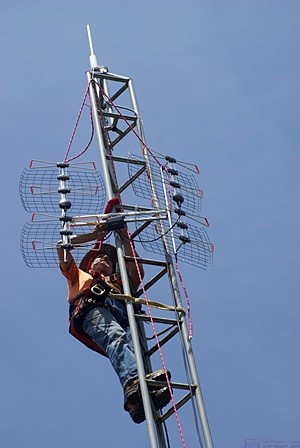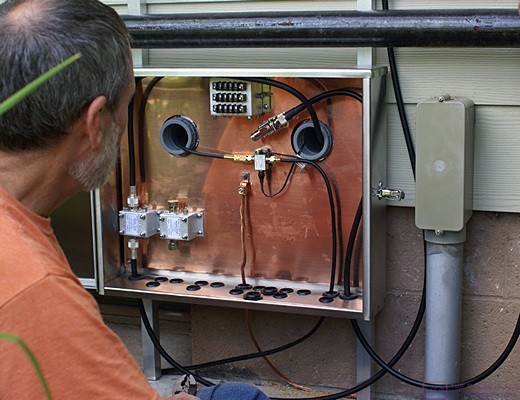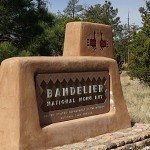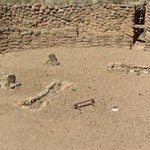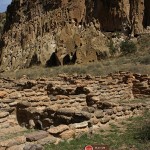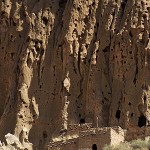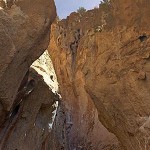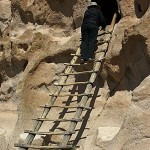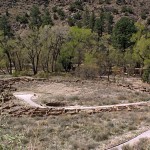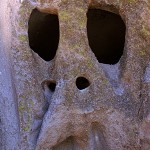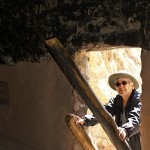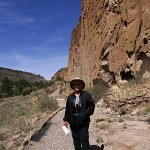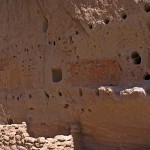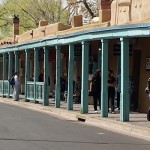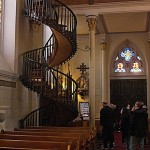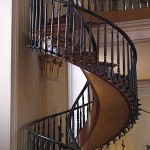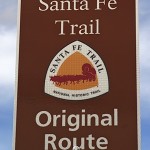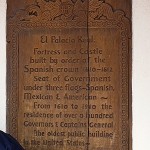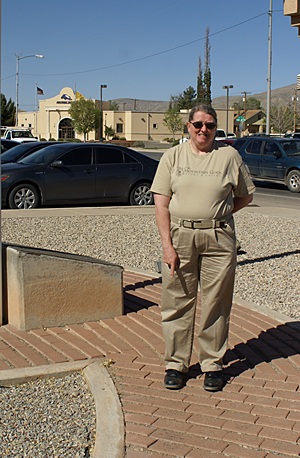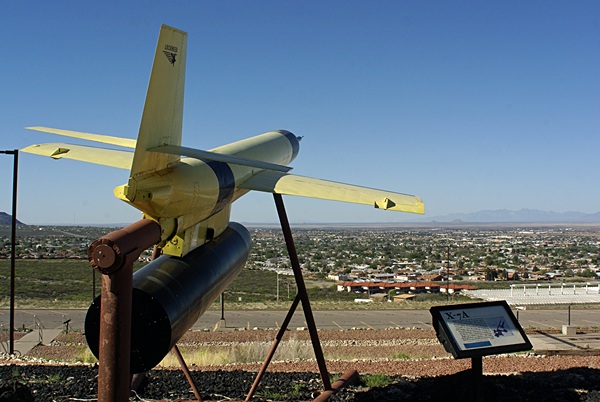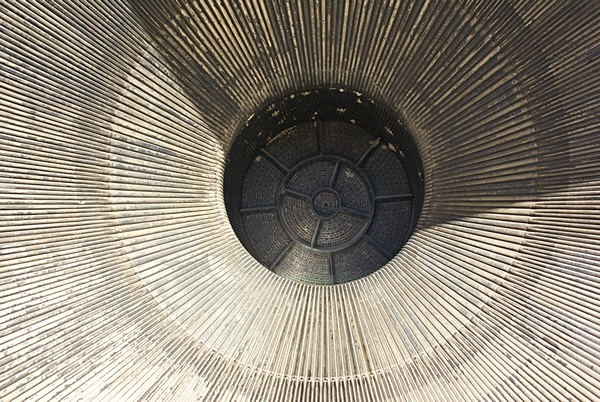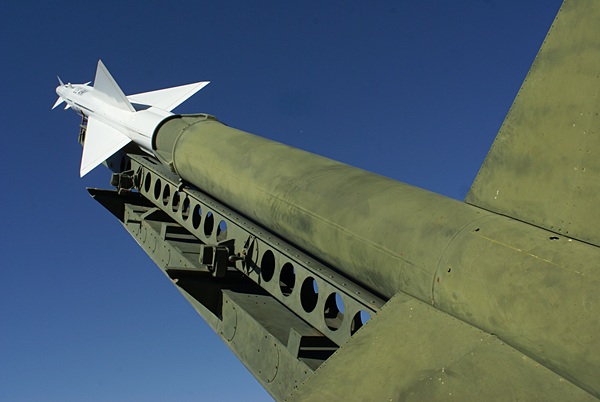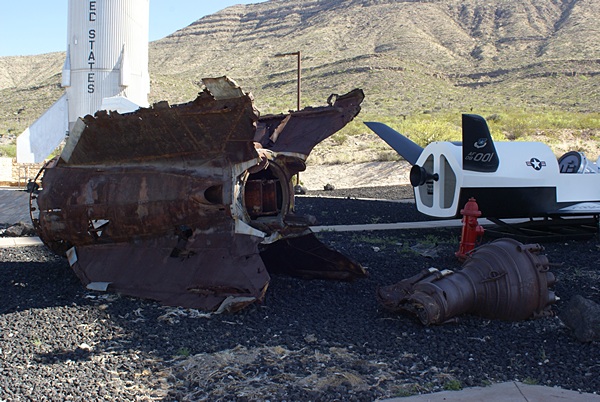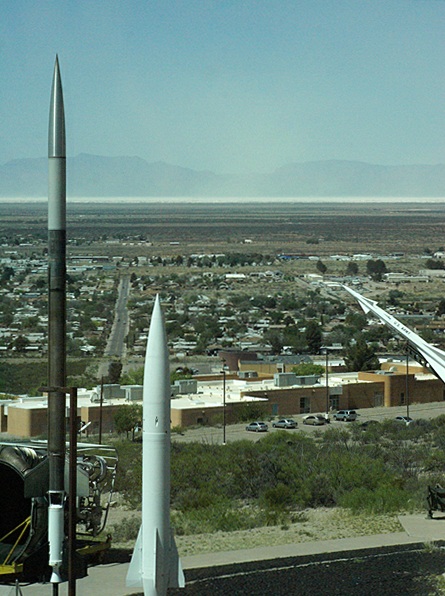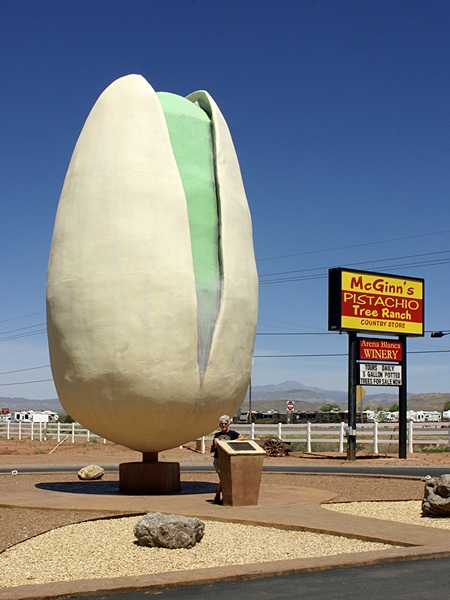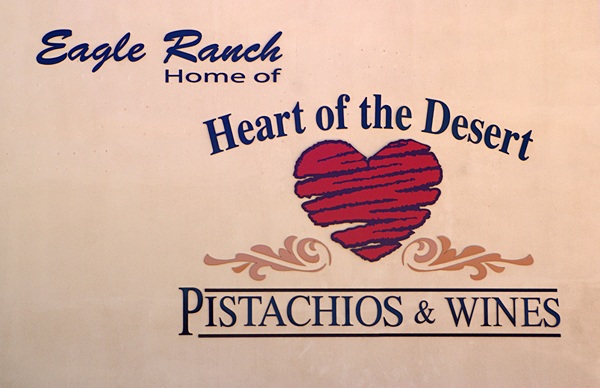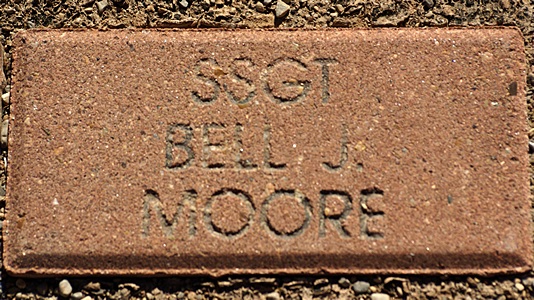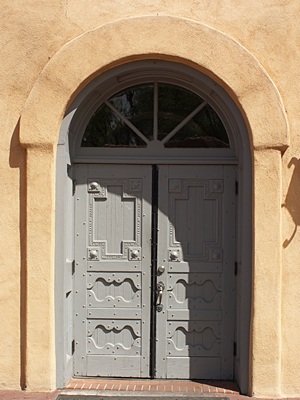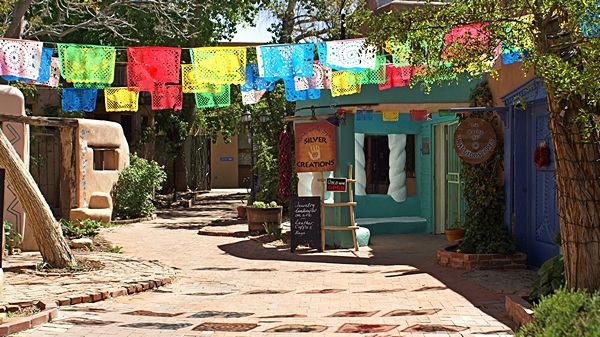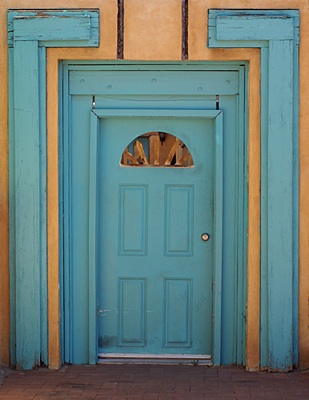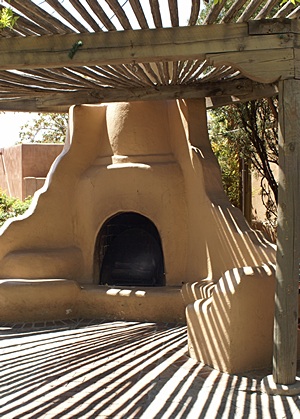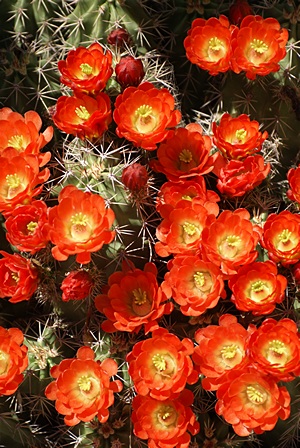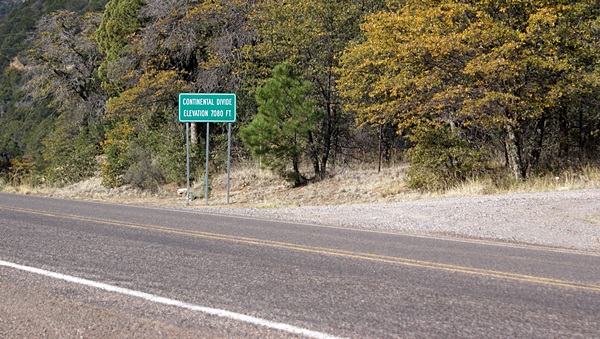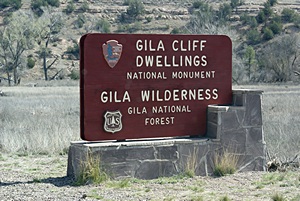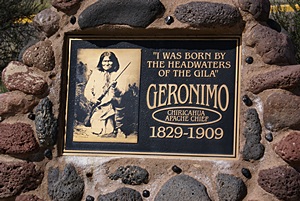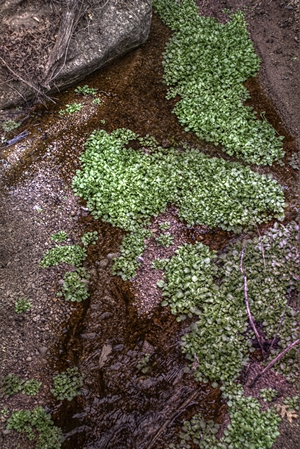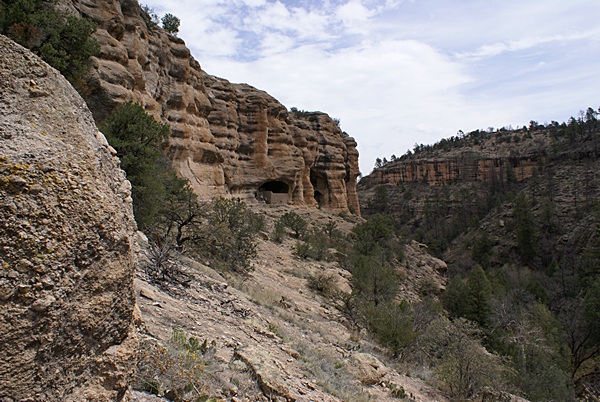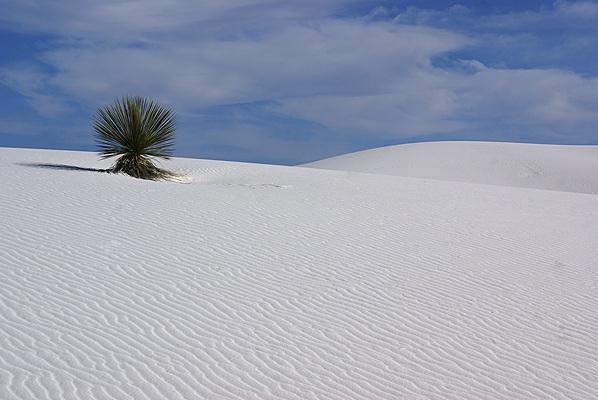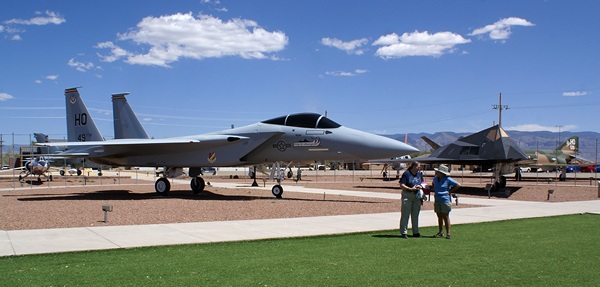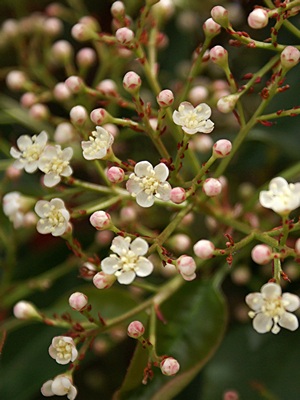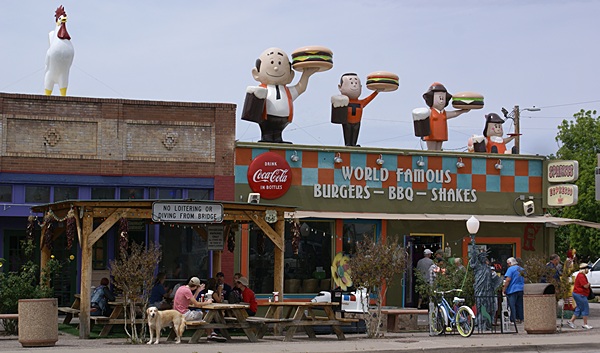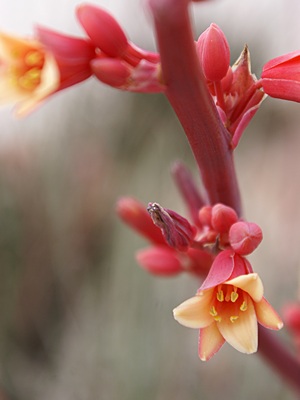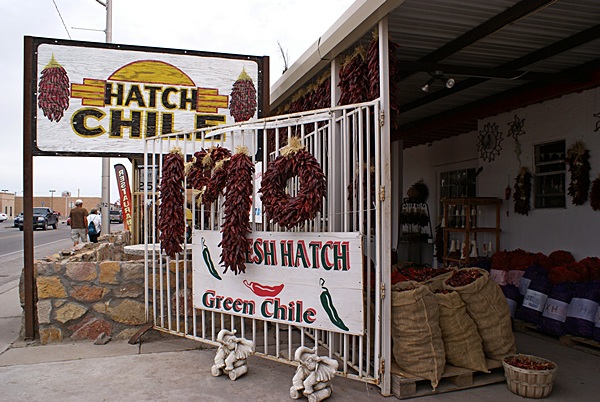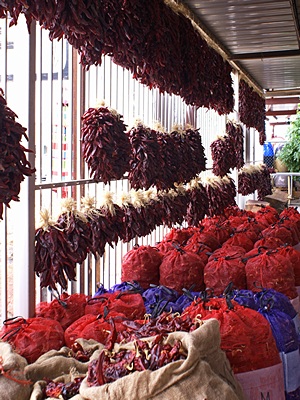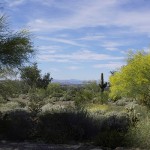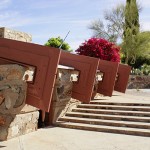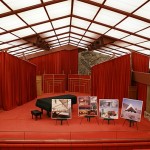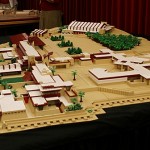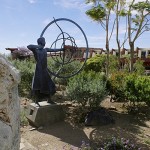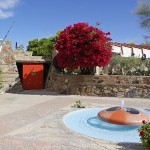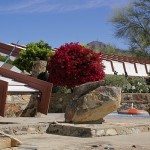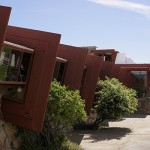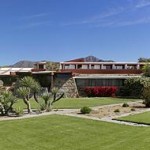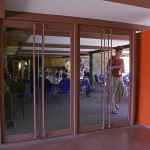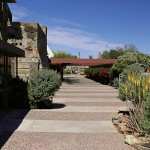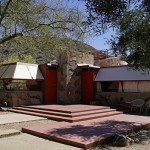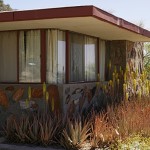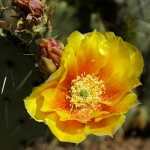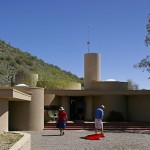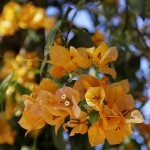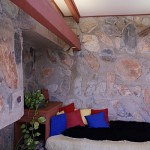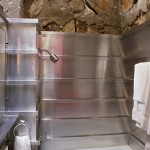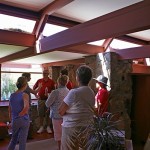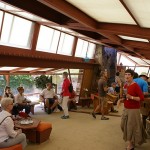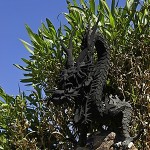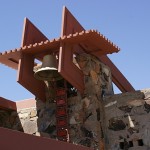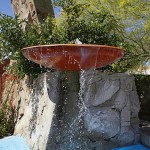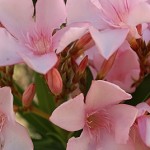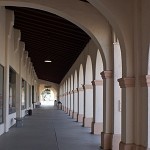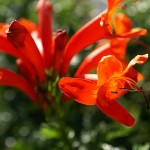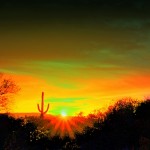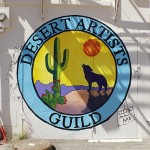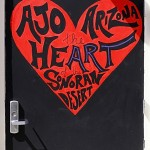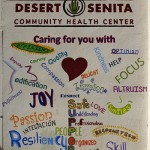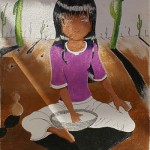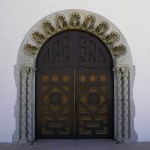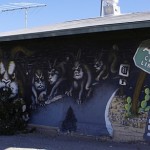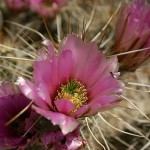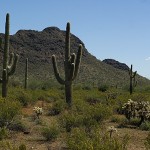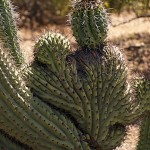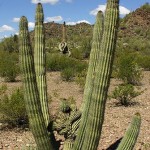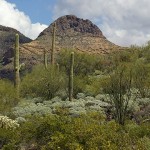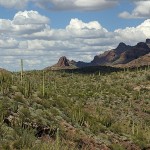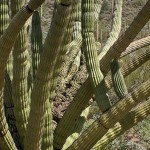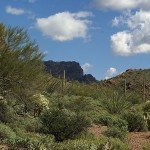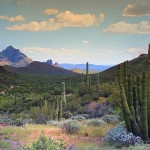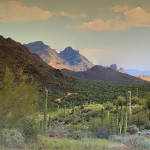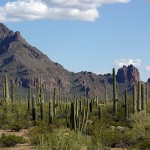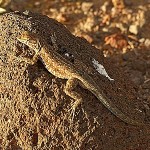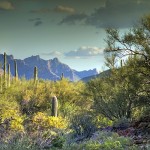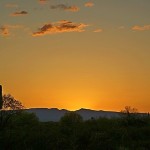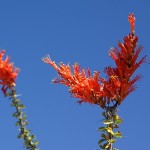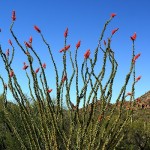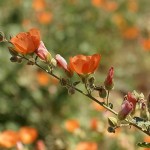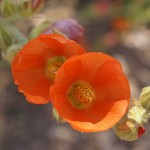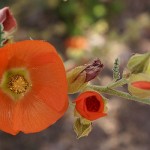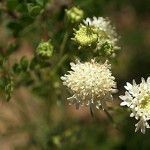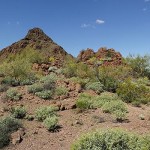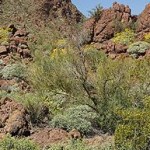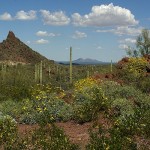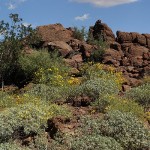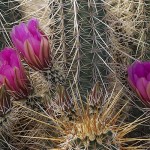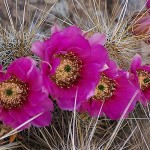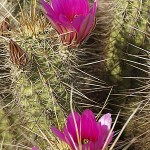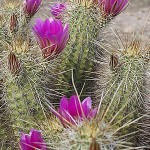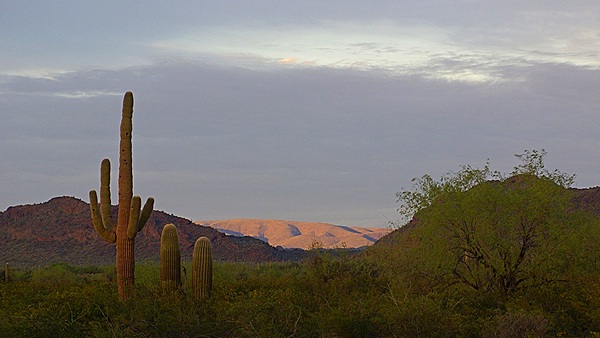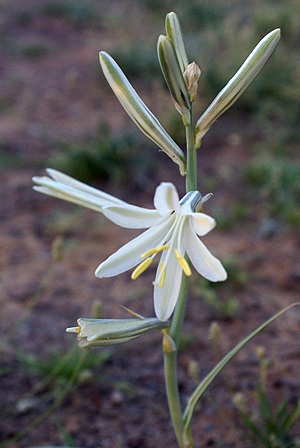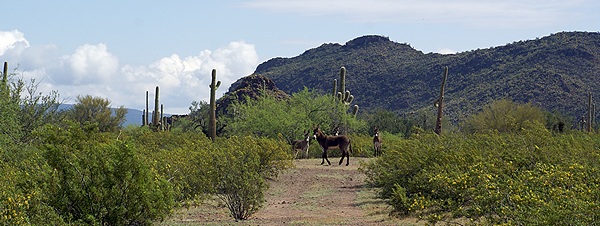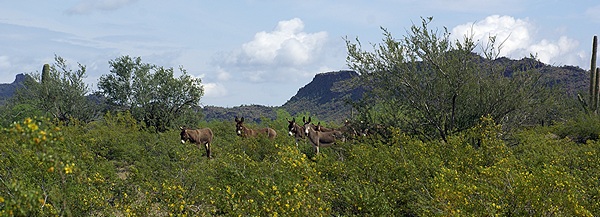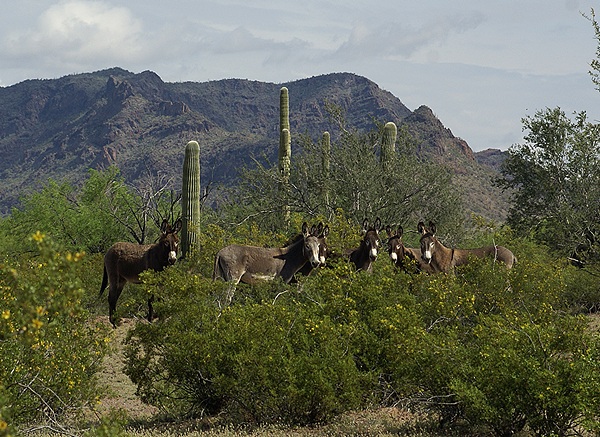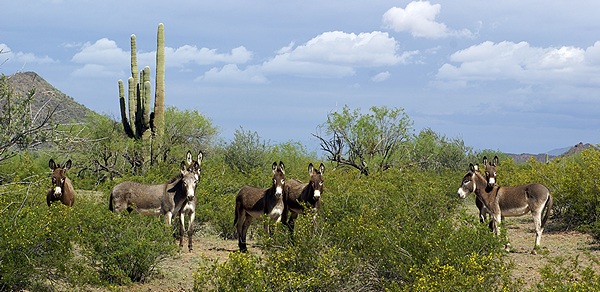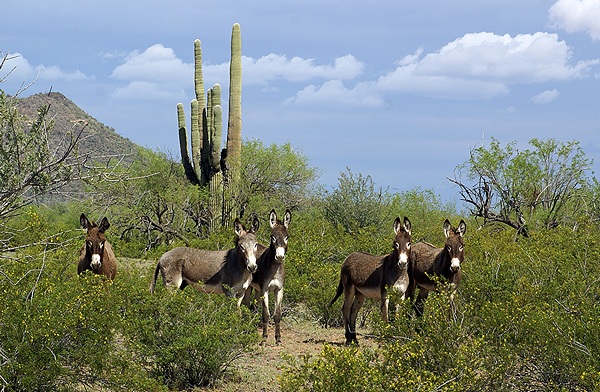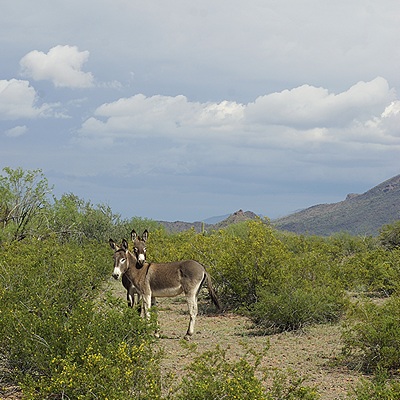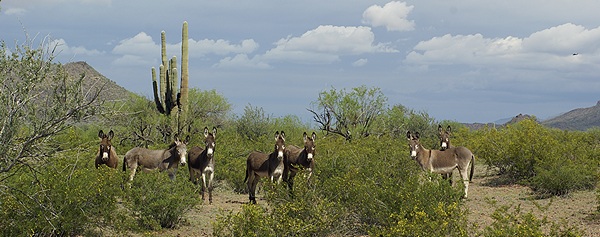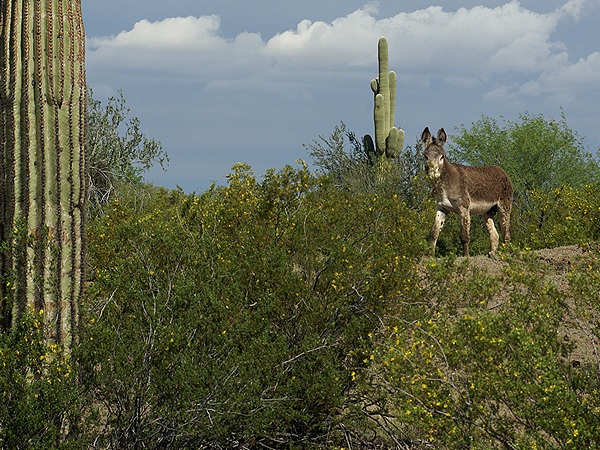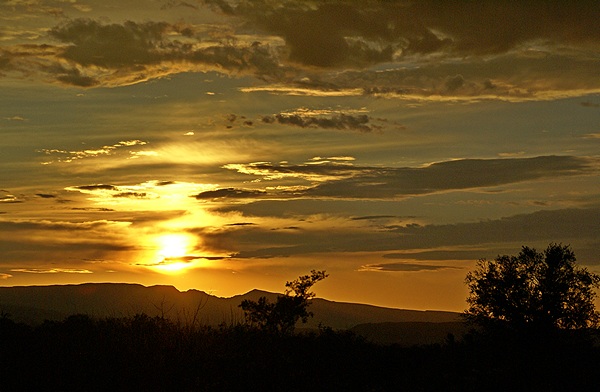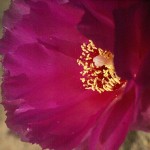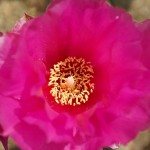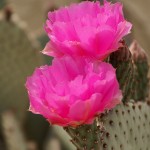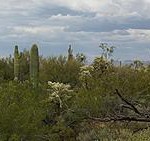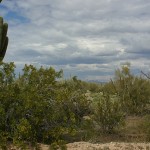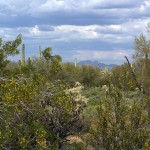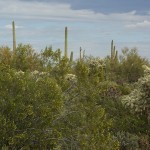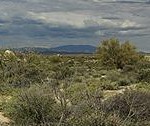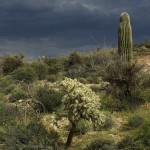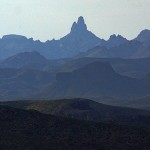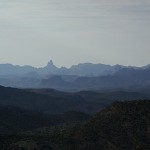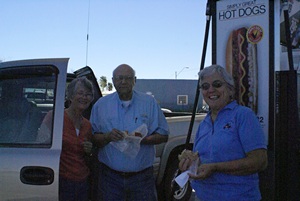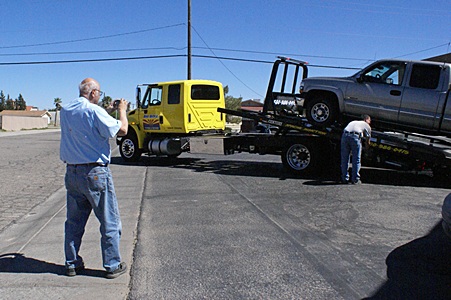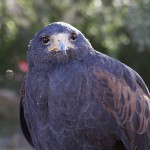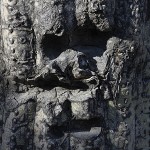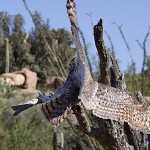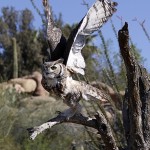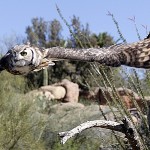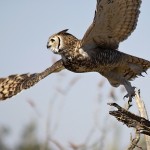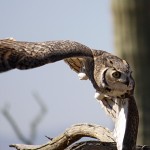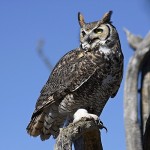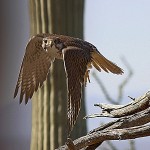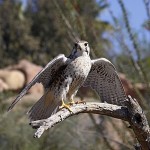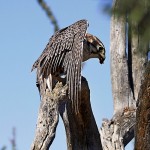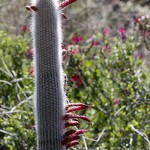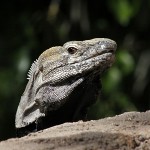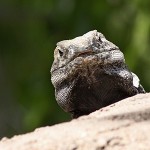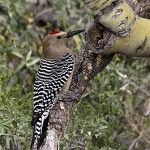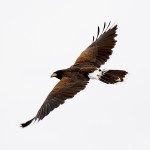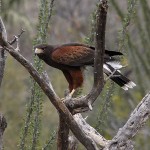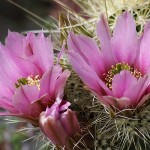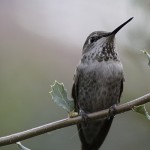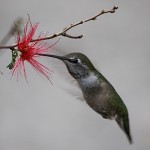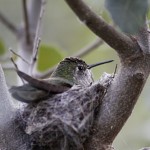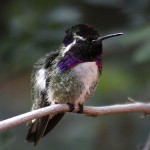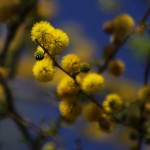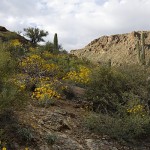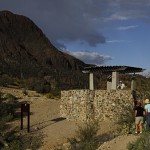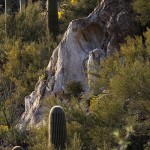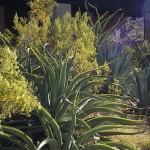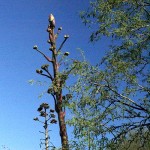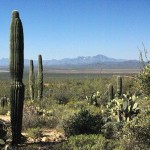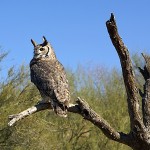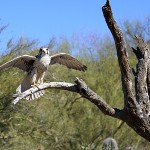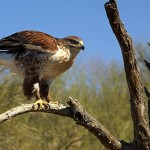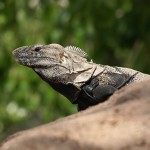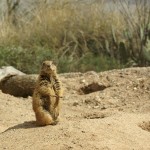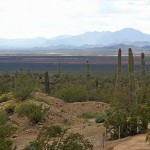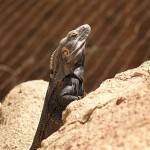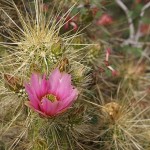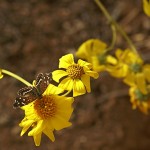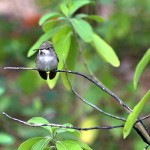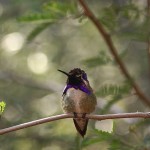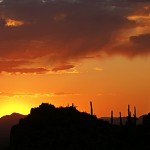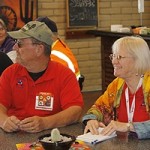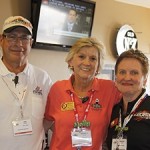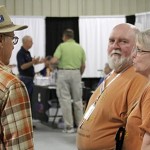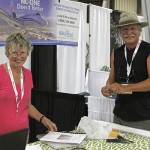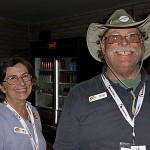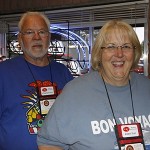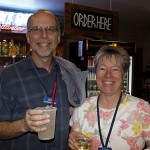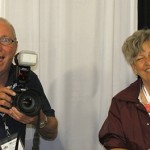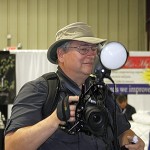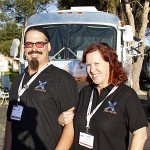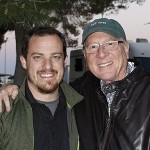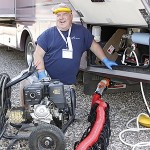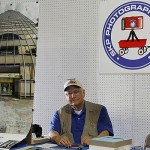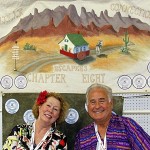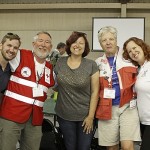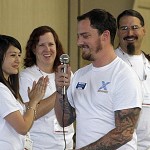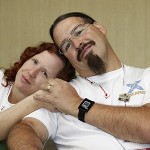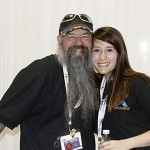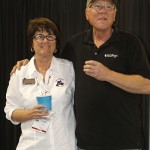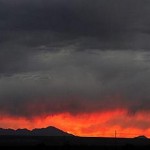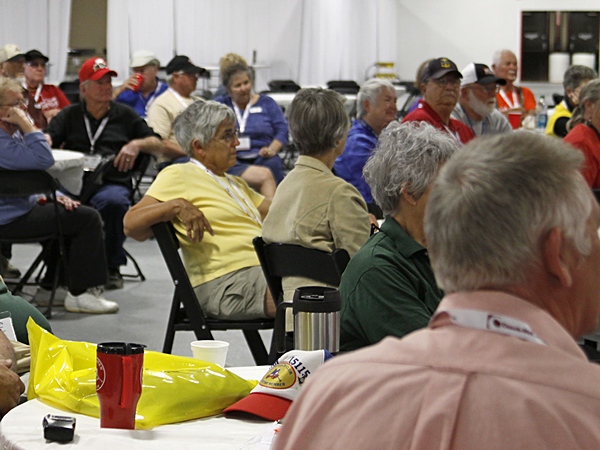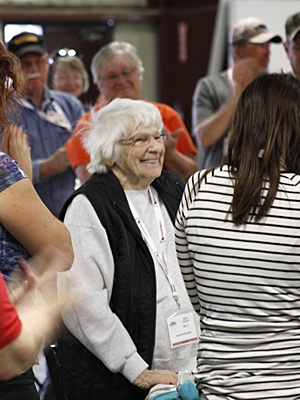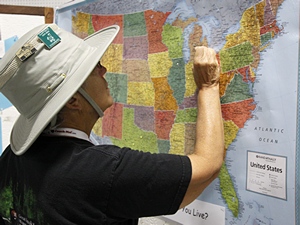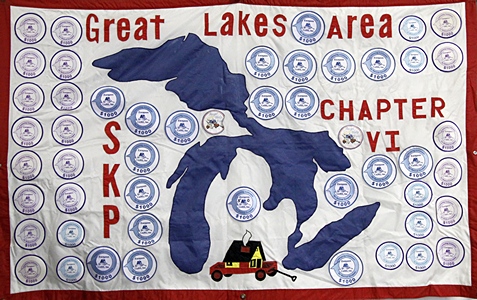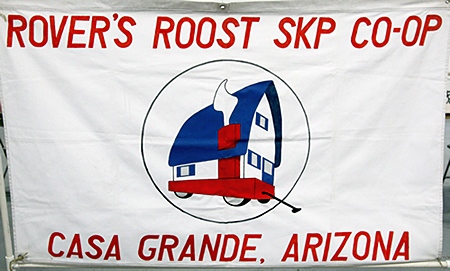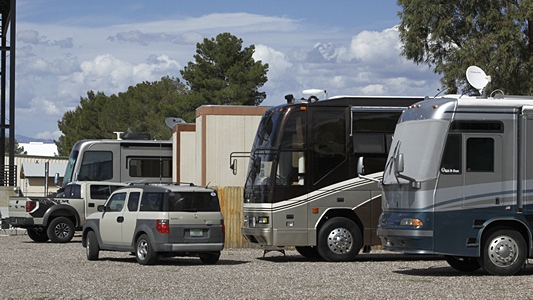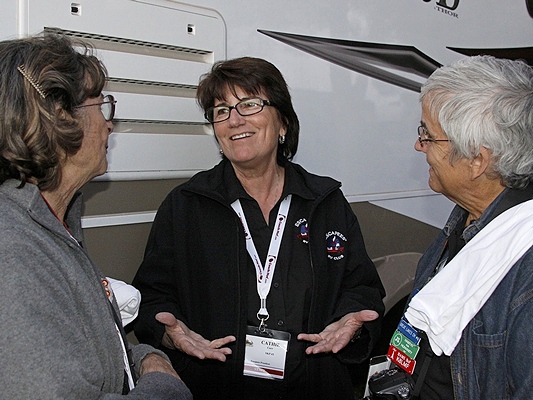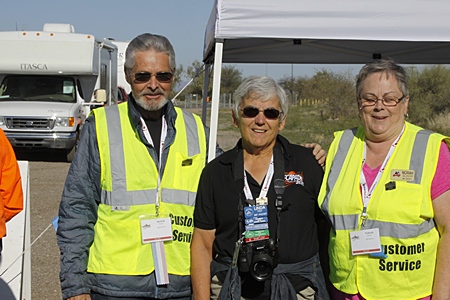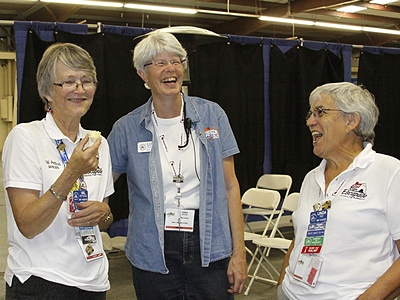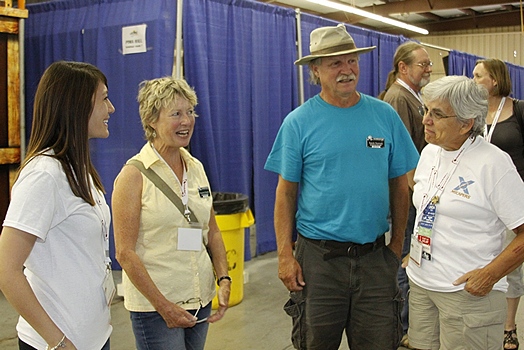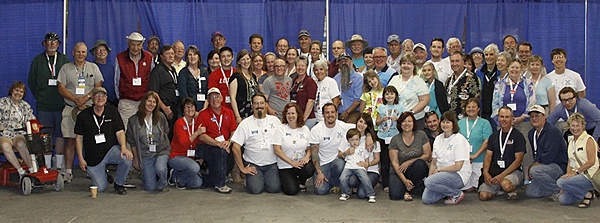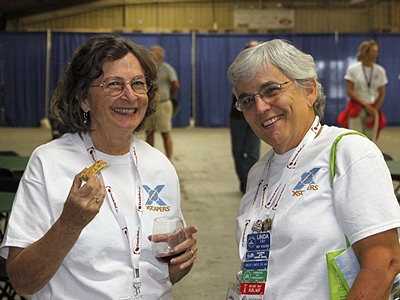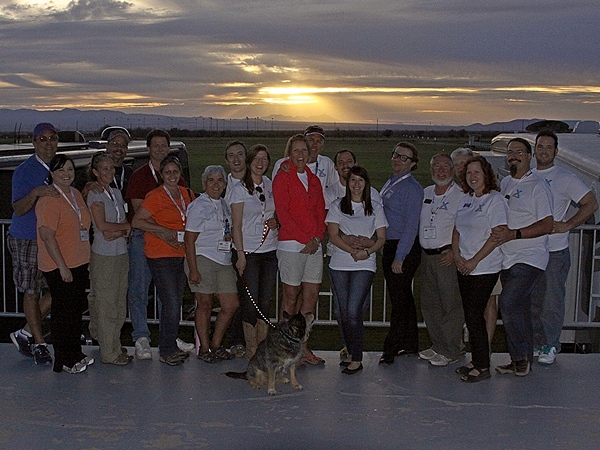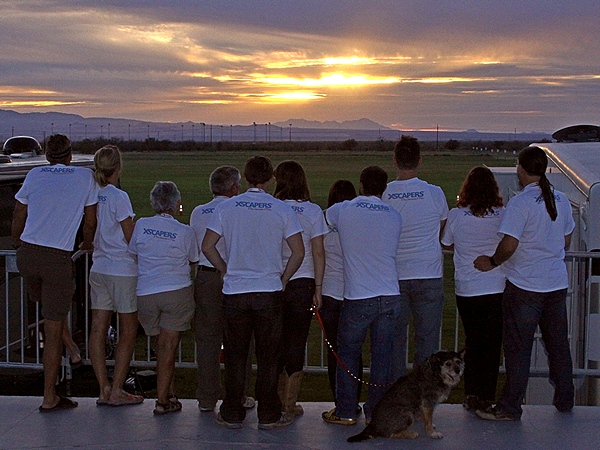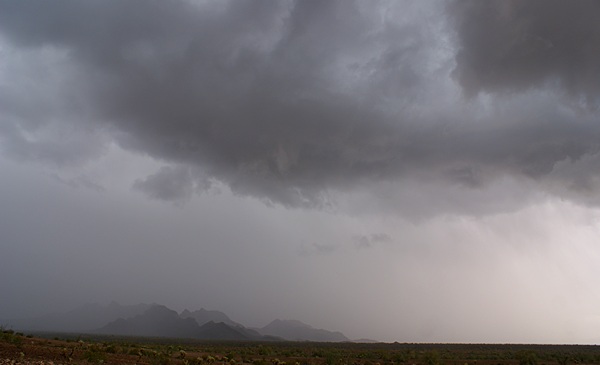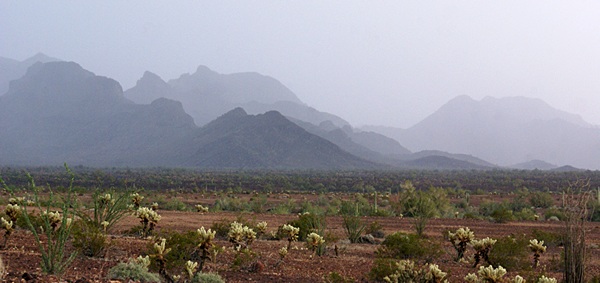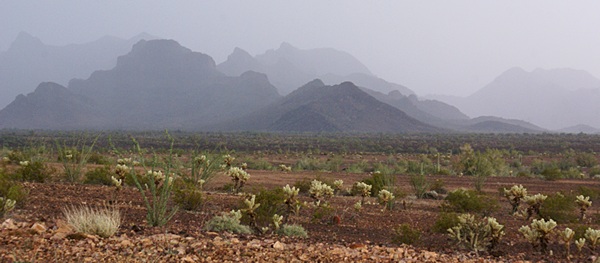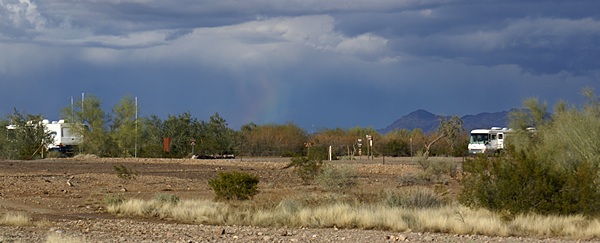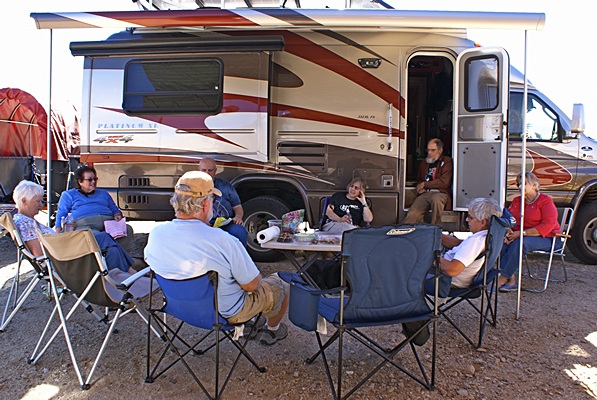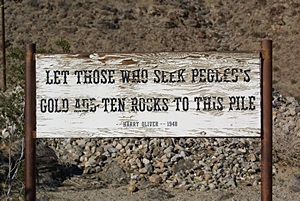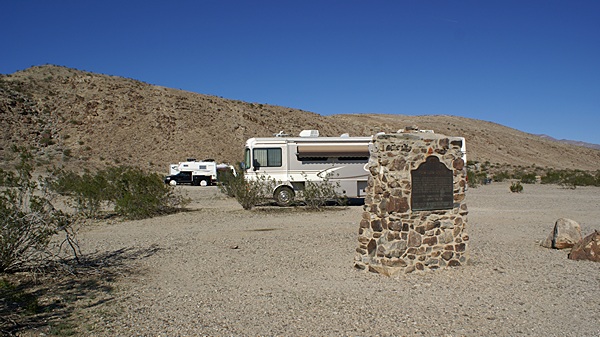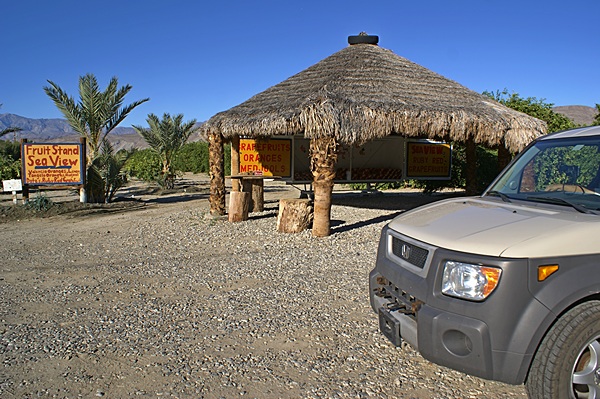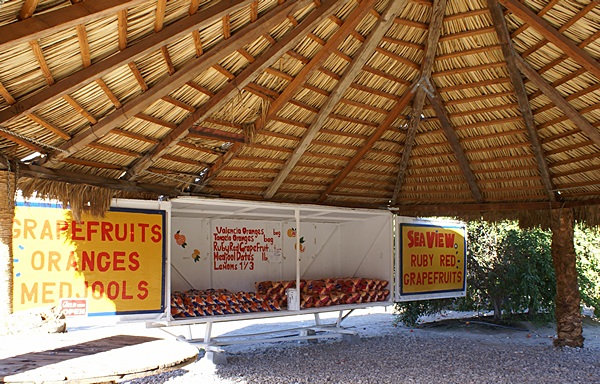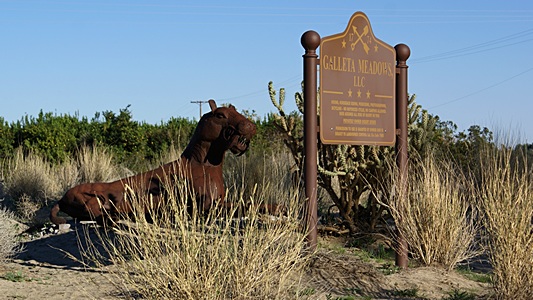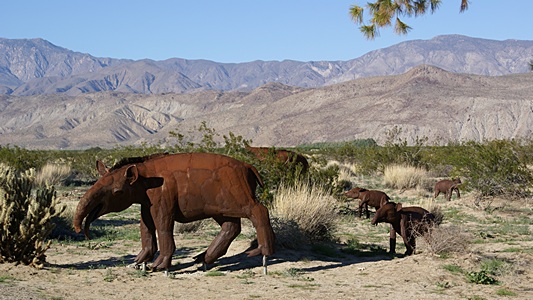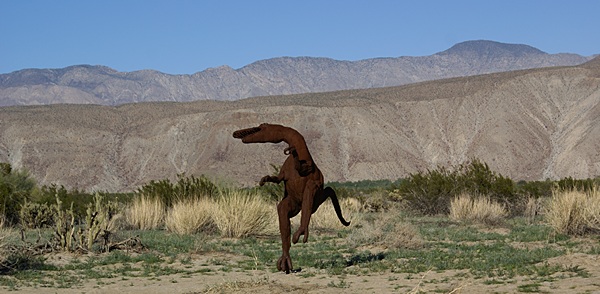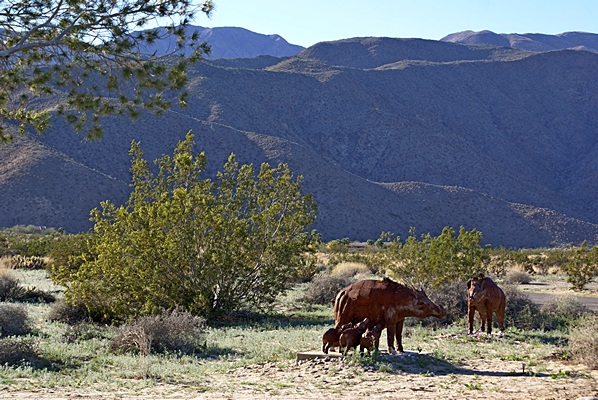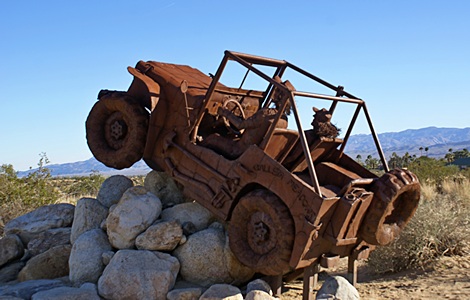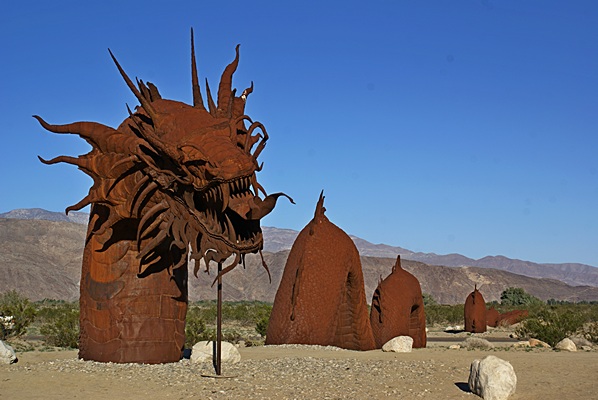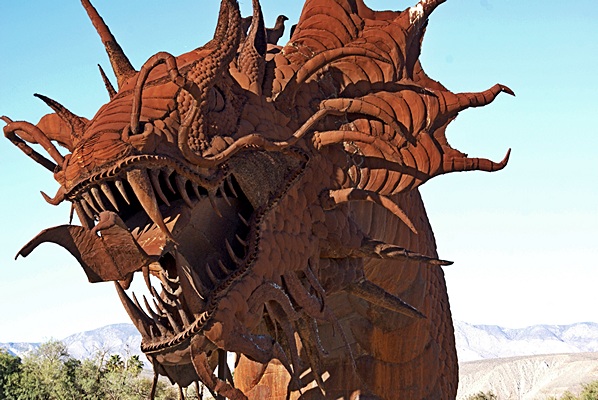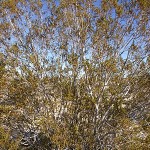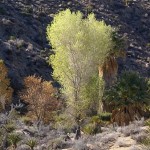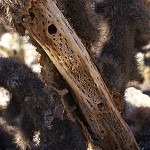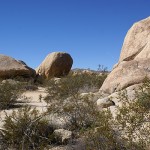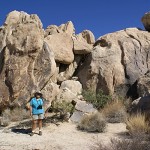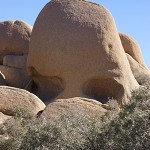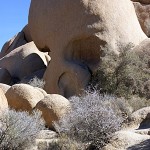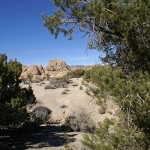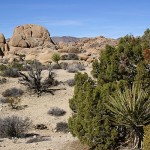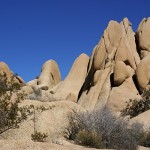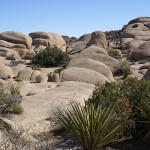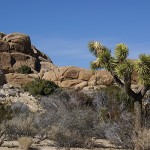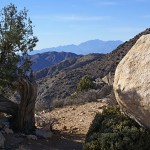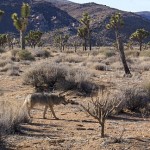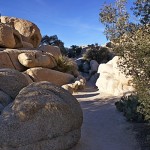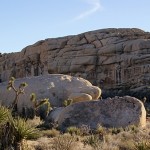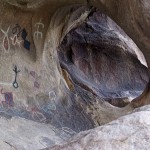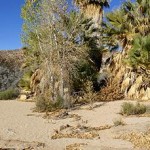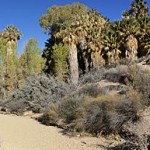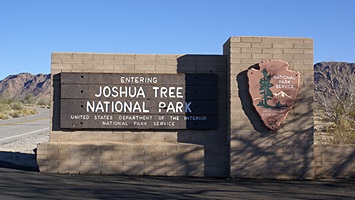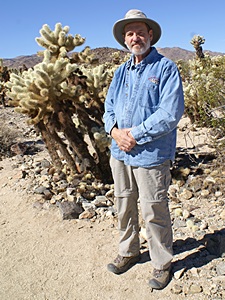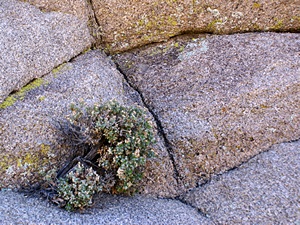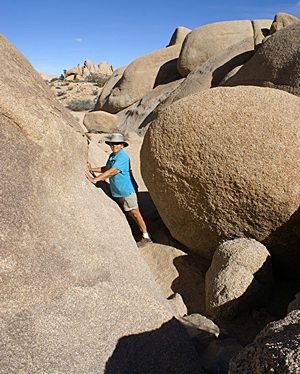2015/02/19 (R) Over-Cranked
I have been busy cleaning/waxing the outside of the bus and writing articles so I have not been able to spend much time writing my blog posts or uploading them to our website. A couple of weeks ago I uploaded the posts through the end of December 2014 but then we got busy and I have not uploaded anything since then.
Here is how my day went. I Got up at 7:30 AM and had granola with fresh blueberries for breakfast. It was cloudy and cool most of the morning, so I tried to focus on the bus cleaning/waxing and was able to clean and wax the passenger side of the bus from the front to the back edge of the dinette fixed window.
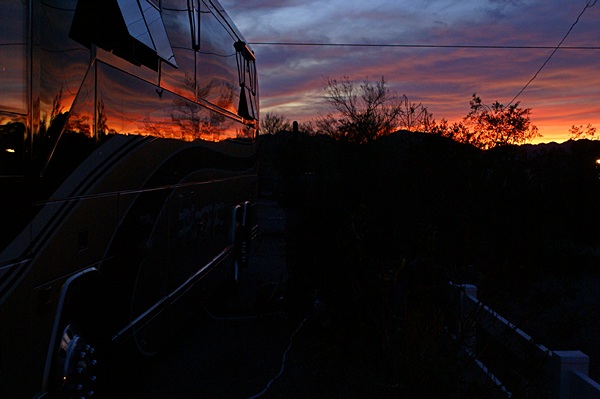
Another dramatic sunset reflected off the recently waxed driver’s side of our coach.
The whole house generator at home runs a self-test every Thursday at 11 AM (EST) and e-mails its status to us. Instead of getting a message at 9 AM I got one at 9:10 AM (MST). The message was an Over Crank fault indicating that the Genset had failed to start, had dropped out of Auto mode, and would not attempt to restart until the controller was reset to clear the fault. I did not assume that Linda had paid any attention to the details of the message so I called her. She called Bratcher Electric and they told her how to reset the controller. They also said they had received similar notifications/calls from other customers. Sure, the temperatures have been below negative 10 degrees F, but the whole reason we have the generator is to protect us against power loss which usually occurs under the worst weather conditions. The service technician is coming out on Wednesday to check the unit, which is still under warranty.
I took a lunch break at 2PM and had a jumbo tofu hot dog and some hummus with a few Fritos corn chips. For most of the rest of the day I worked at my laptop selecting and editing photos for my Quartzsite 2015 BCM article. I made a quick trip to the Road Runner market for some 26 ounce containers of salt and stopped at Herb’s Hardware store looking for a clear filter housing, but they did not have any.
I made a nice, large salad for dinner and finished up the box of Franzia Refreshing White wine. I continued to process photos for my article late into the evening, taking an occasional break to check e-mail and check out the SteelMasters website. They sell steel Quonset hut style building kits and this might be a more economical way to build our bus barn, and easier as a do-it-ourselves project.
2015/02/20 (F) Touch of Oranges
I was up late last night so I slept in until 8 AM this morning. I awoke to cloudy skies and cool temperatures so I skipped breakfast and got right to work cleaning/waxing the passenger side of the bus, which faces south and gets a lot of sun. I have been working front to back but decided to reverse direction. The reason was to do as much of the side aft of the patio awning as possible while it was cloudy. The area under the patio awning is shaded (by the awning) so I can work there anytime I feel like it.
Butch was working on their new VDO electronic speedometer and needed to borrow my air-over-hydraulic bottle jack so I dug it out of the front bay for him. Mid-morning Lou and Donna Rice stopped by to say “hi.” They were in town looking for newspapers that Lou could use to mask off their motorhome so he could spray some paint. It just so happened that there was a large box of newspapers over by the trash container and they were able to get all that they needed at our campsite.
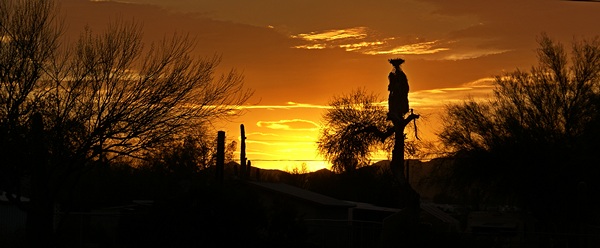
The sunset in Q backlights Saguaro cactus, a palm, and a Palo Verde tree.
I quit cleaning/waxing around 11:45 AM and turned my attention to the water softener. I have regenerated it twice this week, first with solar salt and then with non-iodized table salt, but the water coming out of it is still testing in the 3 – 7 gpg range. A reading of 7 is considered ‘hard’ so at this point I am not very happy with our water softener.
I filled the filter housing with yet another 26 ounces of finely ground non-iodized table salt and started the regen process for the third time this week. This time I ran the water more vigorously for a short time and then slowly (two minutes per gallon) and checked for salty water from the outlet of the softener. When I got very salty water I shut off the flow and let it sit for an hour. I repeated this a couple more times. When I took the filter housing off there was very little salt left in the bottom. I rinsed it out, reinstalled it, and ran water through the unit at the rate of four minutes per gallon for one hour, figuring 15 gallons of filtered water should be enough to flush the saltiness out of the softener. I tested the discharge water from the softener and it measured somewhere between zero and 1.5 gpg TH. It should have been zero, but I do not know if the test strips are sensitive to residual salinity. This process took all afternoon, intermixed with my computer and bus waxing work.
I had granola with fresh blueberries for lunch and then finished yesterday’s post and started this one. I settled in to work on photographs for my article with periodic breaks to check the water softener. It was more sunny than cloudy from noon to 2 PM at which point the clouds thickened and filled in. The air was warm but not hot and the conditions were ideal for cleaning/waxing the “sunny” side of the bus. That is what I did until 5:45 PM, with a short break to talk to Linda on the phone. I should be able to finish the waxing tomorrow, put a second coat of Carnu-B Coconut Creme on the passenger side tires, and put a first coat on the driver side tires.
I cleaned up all of my supplies and materials, washed up, and had a few corn chips and hummus as an appetizer. I washed some red grapes for later and got out an orange. I have a lot of grapefruit and oranges on board at the moment and try to at least one of each every day.
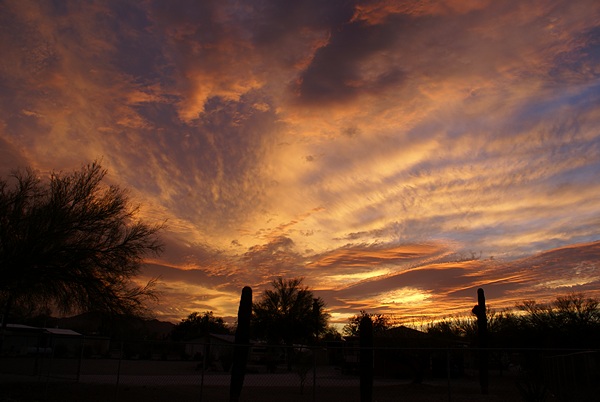
This was a very dramatic sunset.
Speaking of oranges, Barb has been using a pair of products from Touch of Oranges; Touch of Oranges Wood Cleaner & Re-conditioner, and Touch of Beeswax Wood Preserver; http://www.TouchOfOranges.com. I went to their motorhome yesterday to see how it works and the results were quite impressive. I thought about ordering some but decided not to for several reasons. For one, we already have Murphy’s Oil Soap Wood Cleaner on board. It has orange oil in it and I would like to do a side-by-side test. For another, we are getting too close to our departure date to risk a delayed delivery. Finally, we don’t have time to use it before we get home anyway. I might order some in May if I like the way it works better than the Murphy’s product.
I made a fancy salad for dinner. We bought a large container of mixed salad greens on Monday and I need to have salad every day in order to use it up before it goes bad. I found carrots and mushrooms in the fridge that needed to be used, so those went on the salad along with dried fruits, peanuts, Daiya pepper jack “cheese” and other yummies.
I continued processing photos after dinner. By 10:30 PM I was too tired to concentrate and went to bed.
2015/02/21 (S) Facetime with Madeline
I was awake off and on starting at 6 AM and finally got up at 7:15 AM. The Yuma Hamfest started yesterday and runs through tomorrow but I have too much to do here to spend three hours driving just to window shop. Besides, Butch had to leave early this morning for a rock and mineral swap meet to try selling some of the equipment they have purchased and decided not to keep.
I did not have coffee yesterday so that was my second task this morning. My first task was getting the cats their food and water and cleaning their litter tray. I had granola with raisins and fresh blueberries for breakfast and then sat and enjoyed my coffee while Jasper sat beside me on the couch and groomed himself.
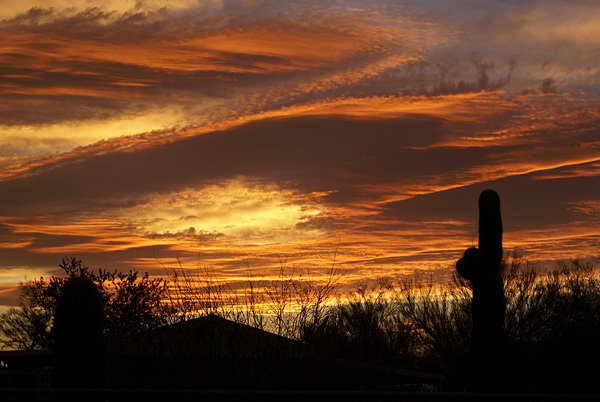
The sunsets in Q were usually good but this one was better than usual.
It was cool again this morning with a thin cloud layer so as soon as I finished my coffee and checked my e-mail I got to work on the outside of the bus. That was at 9:15 AM. It took me until 11:45 AM to finish the passenger side of the bus and apply a coat of Carnu-B Coconut Creme to the driver side tires.
I finished the hummus for lunch with the help of a few Fritos corn chips. Afterwards I called Jeff to check on our coffee order. He said it was in the mail but went out a few days later than expected. He said he expedited the shipping because of that and was supposed to e-mail the USPS tracking number to me. I then went over to Jim and Barb’s rig and asked if I could test their Touch of Oranges products. Barb lent me both the wood cleaner/restorer and the beeswax wood preserver along with pieces of terry cloth for each and a piece of 0000 steel wool. I set those aside and worked on my Quartzsite 2015 article for a while.
I took a break from working at my computer to test the cleaning products. Following the directions, I sprayed the left side of the kitchen base cabinets with the cleaner/restorer, waited two minutes, rubbed it with steel wool (with the grain), and wiped it off. I then applied the beeswax preserver with a piece of terry cloth and let it sit for one hour. While the beeswax product was soaking in I went over and visited with Butch and Fonda. While I was doing that I got a TXT message from Linda asking if I wanted to Facetime. That meant she was back at the house and had grand-daughter Madeline with her. I indicated that a little bit later would be better.
My one hour wait was up so I excused myself, went back to my coach, and wiped down the left side of the cabinet. I then used the Murphy’s Oil Soap Wood Cleaner (with orange oil) on the right side of the cabinet. The results did not compare favorably with the Touch of Oranges products which definitely improved the appearance of the wood.
I turned on our Verizon MiFi, switched my iPad to it, and then called Linda to set up the Facetime session. Either I never configured the Facetime app or failed to reconfigure it but it would not let me log in. Once I got the correct e-mail address and password set up it worked fine. I called Linda’s iPad and when she answered I got to see Madeline. When Linda picked her up earlier today Madeline said she was going to grandma and grandpa’s house to see grandma and grandpa. Linda explained that I wasn’t at the house but Madeline could still see me in the bus using the iPad. It is a fabulous technology, and fascinating to see how completely natural it is for a 2-year old.

I have enjoyed creating panorama images this winter using MS-ICE.
Bill Stewart from our FMCA Freethinkers Chapter had requested to see some photos from the recent gathering at the Peg Leg boondocking area near Borrego Springs, California. Last night I selected seven images, re-sized and processed them, uploaded them to the Freethinkers folder in my Dropbox, generated the “share” link, and e-mailed it to our open forum e-mail reflector. While I was working on that it occurred to me that Lou Petkus is always looking for images for the SKP Photographers BOF newsletter and member album and I had not sent him anything in a while. I was too tired by then to do the work so I put that on my “to do” list for today.
I spent most of the rest of the afternoon and evening working on my article and the photos that go with it except for a break to photograph a beautiful sunset. Linda called around 6 PM (8 PM at home) to chat. She suggested that we wait to see if someone at Escapade is selling the Touch of Oranges products. She also suggested that I check to see if Carnu-B is going to be at any car shows near us as they sell the product for a lot less at shows than they do online.
I took a break for dinner and microwaved a jumbo tofu hotdog and a potato. The potato had started sprouting so I figured I needed to eat it or plant it. I had been accumulating dishes and utensils for the last few days so I washed, rinsed, and dried all of them. By the time I finished my chores, played a few games on my iPad, and finished this post it was midnight. Completing the waxing of the bus was an important milestone, and although I have a lot more to get done on the bus this coming week I plan to take it easy tomorrow and try to wrap up my Quartzsite 2015 article and perhaps some other writing. The most I may do to the bus is apply some more Carnu-B Coconut Creme to the tires.
2015/02/22 (N) Q 2015
I did not use up the second package of blueberries fast enough and they started to go bad. I picked out the bad ones, rinsed off the rest, and had some granola with my blueberries for breakfast. I worked for a little while finishing up yesterday’s blog post and then got to work at my computer. It was cloudy and windy when I got up and the winds continued to strengthen during the day. I had closed the vent fan domes last night so I would not have to listen to them rattle. The patio awning was flapping more than I liked so I got Butch to hold the strap while I released the rafters and then rolled it up and latched it. I was able to retract the small passenger side bedroom awning by myself. In the light of day I discovered that I had not wiped the Carnu-B wax off of the body as completely as I thought. That, however, will be a task for another day.
I wanted to make a sandwich for lunch but I was out of onion so I went to the Road Runner Market to get one. I also wanted pretzels and hummus. They did not have any hummus and they did not have the kind of pretzels I like but I was able to get two large sweet onions. Sourdough bread with Tofurkey brand mock deli slices, Daiya cheddar “cheese” slices, veganaise, honey mustard, fresh onion, and salad greens made a tasty treat.
I finally finished my Quartzsite 2015 article for Bus Conversion Magazine, including the 95 photos and captions, and uploaded it to my Dropbox for proofreading. I had an e-mail back from Gary indicating that they would probably use it for the February issue, so very late this evening I uploaded all of the photo files.
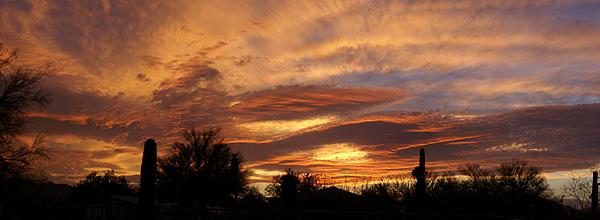
A panorama created using MS-ICE from handheld images.
About the time I needed to take a break Fonda left for church and I saw Butch sitting outside with his camera. Another beautiful Quartzsite sunset was taking form so I grabbed my camera and shirt jacket and went out to join him. It had been cloudy and windy all day and was rather brisk. We both worked the sunset until it was played out and got some nice photos considering that they were all handheld in low-light conditions.
For dinner I made a Thai Kitchen Noodle Bowl and added some honey roasted peanuts. I closed all of the bus windows to a crack and made some hot tea. Tea is still my beverage of choice with any type of Asian cuisine and was very satisfying on a chilly evening.
With the Quartzsite 2015 article done (except for corrections) I started pulling together the “featured bus” article on Byron Pigg’s 1985 Model 15 Eagle bus conversion. I went through the photos I took last month of his coach at the Eagles International Bus Rally and was pleased that I had a good variety with good technical quality to choose from. I made my selections, post-processed all of them, and inserted the small versions into the Word doc. The article narrative itself was less than one page in length as I do not know very much about Byron and his wife Betty or their bus. The Word doc template I use for featured bus articles includes two “Specifications” pages, one for the bus and one for the conversion, so the article was three pages. I e-mailed the Word doc (with embedded photos) to Byron and cc:d Gary at BCM. In order to complete the article I need Byron to fill in a lot of the details about his bus and conversion.
2015/02/23 (M) Seizure
Toast with apricot preserves is as close as I get anymore to the Danish pastries that were once one of my favorite treats, but I am OK with that. I am absolutely enjoying retirement more as a result of being much healthier and more active, both of which are a direct consequence of eating better, weighing less, and not having to take a cocktail of drugs every day. Toast, coffee, and a little fruit juice makes a very agreeable breakfast.
I finished up yesterday’s blog post after breakfast and then got into my computer-based work. I had planned to work on the photos of Larry and Carol Hall’s GM PD4106 bus conversion and write a brief narrative, similar to the one I did on Byron and Betty’s Eagle bus, but other things kept interfering with the work. Except for lunch and dinner breaks, and brief chats with Barb, Butch, and Fonda, I sat on my butt most of the day working away at my computer on a template for featured bus articles but had very little to show for it at the end of the day.
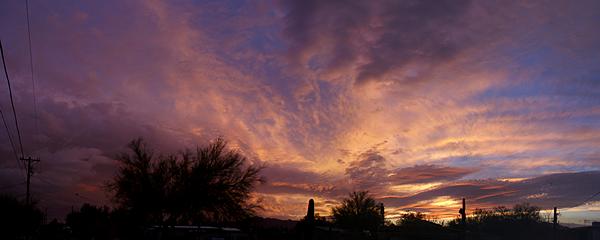
I have learned over the years to stick with sunsets until it is dark. Panorama stitched together with MS-ICE.
For lunch I had the last jumbo vegan hotdog in the open pack. They microwave nicely, so they are quick and easy to fix, and are so yummy with honey mustard, pickle relish, and chopped sweet onion.
I had not yet seen the e-mail from Jeff at Teeko’s Coffee and Tea in Howell, Michigan with the USPS tracking number for my coffee order so I call them at noon (2 PM EST) and Mary gave the number to me over the phone. It only occurred to me much later that the e-mail may have gotten trapped by our spam filter. I direct all of the notifications from the spam filter to a special inbox and I have not made a habit of checking that inbox or going into the filter to release or delete the e-mails that are being held.
Butch and Fonda drove over to Bouse this morning to talk with the General Manager and park managers of an RV Park about working there next season. They stopped at our shared P. O. Box on their way back and then went to the main office downtown. When they got back to camp they had my coffee shipment and an envelope from Dan Fregin, the treasurer of our FMCA Freethinkers chapter.
At one point in the afternoon I looked out the picture window by the dinette, where I sit and work at my computer, and Roho was lying on the ground with Jim and Barb and Jim L. gathered around him. He appeared to be twitching and Barb confirmed that he was having a seizure and typically has one once a month like clockwork. We had a dog with Epilepsy (Scout) and it did not turn out well. The standard treatment at the time (18 years ago?) was phenobarbital, the same drug used to control the condition in humans. Scout did not respond to small doses and the amount we had to give him eventually destroyed his liver. But we had no choice; he went into a grand mall seizure one night and would not come out of it. We had to take him to an emergency veterinary clinic at 2 AM and they had to inject him with phenobarbital and something else to get the seizure to stop.
We had just started him on an experimental treatment using potassium bromide (KBr) dissolved in flavored pancake syrup when his liver failed and he died. I told Barb about this but I did not know if the KBr treatment had become standard practice or not. The apparent effect of the KBr was to mediate the uptake of the phenobarbital, allowing much smaller doses to be much more effective. I searched online later and found that KBr has, indeed, become part of the standard treatment arsenal for canine and feline seizures.
For dinner I made a big green salad. While pulling ingredients out of the refrigerator I found a bunch of asparagus that was spoiled so I threw it out. That was too bad because I really like asparagus and this bunch probably came from the farmers market where we have bought very good produce. I also had to throw away some blueberries and carrots this week but managed to salvage some of each. I did, however, finish up the mushrooms in my salad.
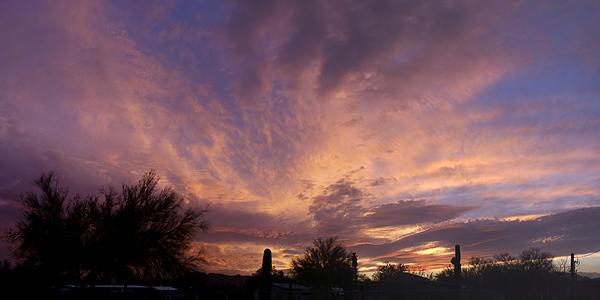
Atmospheric conditions make all the difference in sunrise and sunset photography. Panorama stitched with MS-ICE.
Linda called around 7 PM (my time) and we brought each other up to date on how our days went. Around 8 PM I prepped the remaining strawberries for later and then heated an Amy’s vegan tamale with Mexican rice.
I finally put aside the featured bus article template I worked on much of the day and started selecting and processing the photos for the article on the Hall’s bus. By that point, however, I was tired and frustrated and making mistakes so I went to bed. The southerly winds that brought the rain had shifted to the northwest bringing cool, clear air with them. It had cooled off enough in the bus that I turned on the electric heating pad for the first time in quite a while.
